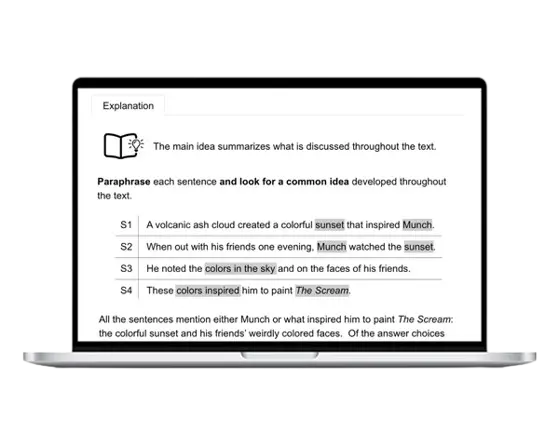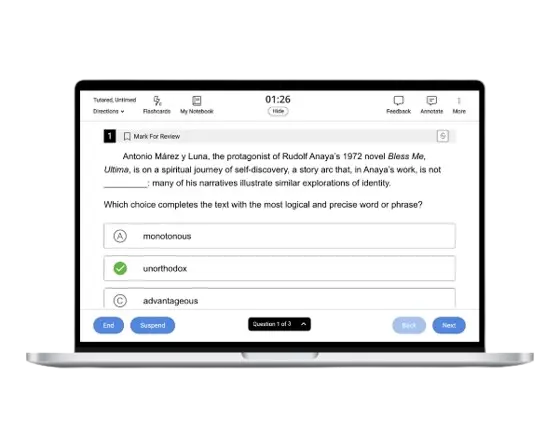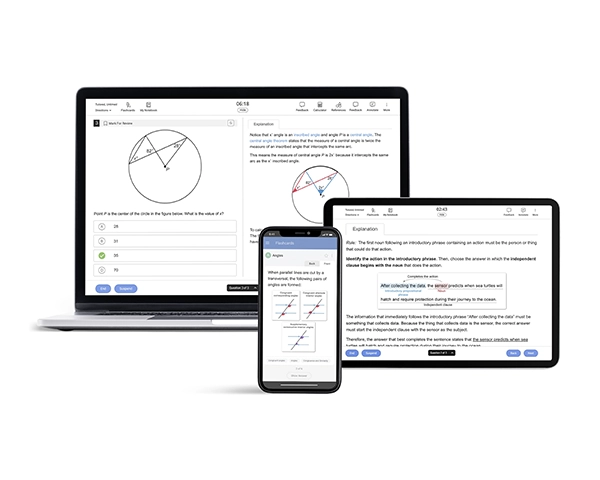The SAT® Reading and Writing test evaluates critical reading, comprehension, and language skills vital for success in higher education. It also reflects the growing importance of digital literacy in academic and professional settings.
This section gives you 64 minutes to complete 54 questions across 2 equal-length modules. Each module presents a range of passages with diverse subjects and writing styles, testing your ability to comprehend, evaluate, and revise written texts.
| Reading and Writing (RW)1 | Duration | Number of Questions |
|---|---|---|
| Module 1 | 32 minutes | 27 |
| Module 2 | 32 minutes | 27 |
SAT Reading and Writing Format & Syllabus
The current SAT Reading and Writing section differs significantly from older versions. It now includes shorter passages with only 1 question per passage, requiring strong time management skills. You have about 1 minute and 11 seconds per question — 54 questions in 1 hour and 4 minutes.
Although question types and assessed skills remain consistent, the section now combines reading and writing into one integrated format. For more insights, explore our SAT Study Guide.
What Types of Questions Are on the SAT Reading and Writing Test?
The section assesses reading comprehension, language use, rhetorical understanding, and editing skills. Passages range from 25 to 150 words and cover subjects such as literature, history/social studies, humanities, and science. These passages cover subject areas such as literature, history/social studies, the humanities, and science.
The questions in the Reading and Writing section fall into 4 main categories:
- Information and Ideas: Understanding, interpreting, and evaluating information from texts and infographics
- Craft and Structure: Determining the meaning of academic words and phrases, evaluating texts rhetorically, and making connections between related texts
- Expression of Ideas: Using revision skills to improve written expression and achieve specific rhetorical goals
- Standard English Conventions: Applying editing skills to conform texts to the conventions of Standard English
For a detailed breakdown of the SAT syllabus, read our What is on the SAT page. If you're looking for a structured prep plan, check out our SAT Course to help you master every section with confidence.

How to Calculate an SAT Reading and Writing Score
Your SAT Reading and Writing score is calculated using the following steps:
- Find your raw score: Add the number of correct answers you got in the Reading and Writing section. Each correct answer earns you 1 point.
- Convert to a scaled score: Use the College Board®’s scoring tables to convert your raw score into a scaled score (200-800).
- Combine your scaled scores: Your scaled score directly represents your performance in the Reading and Writing section.
- Interpret your results: Refer to your SAT score report to see your percentile ranking and how your score compares to other test-takers.
What is a good SAT Reading and Writing score?
A Reading score of 700 and above is considered a competitive score for this section. Check out our blog on what is a good and bad digital SAT score to learn more.
What is the average SAT Reading and Writing score?
According to the 2024 College Board report, the average SAT Reading and Writing score is 519. Check out our SAT scoring guide for a sneak peek into how your SAT Reading, Writing, and Math tests are scored.
What is a bad SAT Reading and Writing score?
A Reading and Writing score that is below the national average section score (as mentioned on your SAT score report) can be considered a low SAT Reading score. Focused practice using our reliable SAT Question Bank can help boost your score.
SAT Reading and Writing Review Tips
Preparing for the SAT Reading and Writing section requires strategy and consistent effort. Here are a few expert-backed tips:
-
Familiarize Yourself with the Format
Manage Your Time Wisely
Use the Elimination Method
Practice Consistently
Optimize Your Reading
Track Your Timing
Don’t Leave Questions Blank
Understand the section layout and tools before test day. Knowing the navigation and question styles helps reduce anxiety and improves focus.
Preview the questions before reading the passage. This helps you target key parts of the text and locate answers more efficiently.
When faced with challenging questions, employ the elimination technique to narrow down options. Digital platforms often provide tools for marking and eliminating choices, enhancing your ability to discern correct answers efficiently.
Regular practice builds confidence and speed. Utilize online resources like UWorld's SAT practice tests to simulate exam conditions and refine your skills. The more you practice, the more confident and proficient you'll become in tackling various question types.
Skim passages for structure and key points. Use annotation and highlighting features to stay engaged and quickly refer back during question-solving.
Aim for about 1 minute and 11 seconds per question. Watch the clock and pace yourself to avoid rushing through the last few items.
There’s no penalty for guessing, so always answer every question. Use logic and elimination to make educated guesses when necessary..
Applying these tips and practicing regularly can improve your accuracy and efficiency, paving the way to a higher SAT Reading and Writing score.

References
- College Board. (2024). How the SAT is structured. SAT Suite of Assessments. Retrieved April 15, 2025, from https://satsuite.collegeboard.org/sat/whats-on-the-test/structure
- College Board. (2024). What the reading and writing passages are like. SAT Suite of Assessments. Retrieved April 15, 2025, from https://satsuite.collegeboard.org/sat/whats-on-the-test/reading-writing
- College Board. (2024). 2024 SAT Suite of Assessments Annual Report. Retrieved April 15, 2025, from https://reports.collegeboard.org/media/pdf/2024-total-group-sat-suite-of-assessments-annual-report-ADA.pdf
- College Board. (2024). How will test questions on the SAT look different? SAT Suite of Assessments – Help Center. Retrieved April 15, 2025, from https://satsuite.collegeboard.org/help-center/how-will-test-questions-sat-look-different
Read More Related Articles
About SAT MathDeepen your understanding of SAT Math for better readiness. Access expert tips, strategies, and practice tools to strengthen your preparation and succeed on test day.
SAT Math Practice TestsBoost your skills with SAT Math practice tests. Access expert-crafted questions, detailed explanations, and strategies to improve your performance and confidence.
SAT Reading & Writing Practice TestsEnhance your skills with the SAT Reading & Writing practice tests. Access valuable resources and practice materials to optimize your preparation and ace the exam.
Free SAT Practice TestsAccess free SAT practice tests that mirror the actual exam format. These full-length tests cover all sections and offer a realistic experience to boost readiness.

